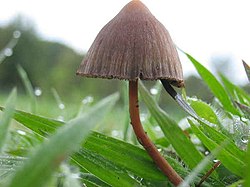Psilocybe mexicana
| Psilocybe mexicana | |
|---|---|

| |
| Scientific classification | |
| Kingdom: | |
| Division: | |
| Class: | |
| Order: | |
| Family: | |
| Genus: | |
| Species: | P. mexicana
|
| Binomial name | |
| Psilocybe mexicana | |
| Psilocybe mexicana | |
|---|---|
| Gills on hymenium | |
| Cap is conical or umbonate | |
| Hymenium is adnate | |
| Stipe is bare | |
| Spore print is purple-brown | |
| Ecology is saprotrophic | |
| Edibility is psychoactive | |
Psilocybe mexicana is a psychedelic mushroom, it was from this species that Dr. Albert Hofmann first isolated and named the active compounds, psilocybin and psilocin in 1958. First used by the early natives of Central America over 2,000 years ago, known to the Aztecs as teonanacatl ("flesh of the gods").
It is in the section Mexicanae, other mushrooms in this section include Psilocybe acutipilia, Psilocybe antioquensis, Psilocybe armandii, Psilocybe atlantis, Psilocybe galindoi, Psilocybe makarorae, Psilocybe pericystis, Psilocybe samuiensis, Psilocybe subacutipilea, and Psilocybe tampanensis.
Description
- Cap: (0.5)1 — 2(3) cm in diameter, conic to campanulate or subumbonate and often with a slight papilla, hygrophanous or glabrescent, even to striate at the margin, ocherous to brown or beige to straw color in age, sometimes with blueish or greenish tones, easily turning blue when injured.
- Gills: Adnate or adnexed, gray to purple-brown with whitish edges.
- Spore Print: Dark purple-brown
- Stipe: 4 — 10(12.5) cm tall x 1 — 2(3) mm thick, equal, hollow, straw color to brownish or reddish-brown, becoming darker where injured, annulus absent.
- Odor: Farinaceous
- Taste: Farinaceous
- Microscopic features: Spores 8 — 12 x 5 — 8 µm. Ovoid and smooth.
Like some other grassland species such as Psilocybe semilanceata, Psilocybe tampanensis and Conocybe cyanopus, Psilocybe mexicana, may form sclerotia, a dormant form of the organism, which affords it some protection from wildfires and other natural disasters.[1]
Distribution and habitat
Psilocybe mexicana Solitary or in small groups among moss along roadsides and trails, humid meadows or cornfields, particularly in the grassy areas bordering deciduous forests, and limestone regions. Common at elevations between 1000–1800 feet, rare in lower elevations, known only from Mexico and Guatemala. Fruiting takes place from May to October.
Consumption and cultivation
Like several other psychedelic mushrooms in the same genus, P. mexicana has been consumed by indigenous Central American peoples for its entheogenic effects. In the Nahuatl language, the fungus is known as Teonanácatl—agglutinative form of the words teó(ti) ("god") and nanácatl ("mushroom")—"god-mushroom."
In the western world, usually the sclerotia of p. mexicana ('Mexicana A' strain) are cultivated for psychedelic use. The sclerotia have a lower content of active substances than the actual mushrooms themselves. These are traded under the pseudonym truffles.
Gallery
-
Psilocybe mexicana from Jalisco, Mexico
-
Psilocybe mexicana from Jalisco, Mexico
-
Psilocybe mexicana drawing
References
- ^ Psilocybin Mushrooms of the World -- An Identification Guide, Paul Stamets, 1996. ISBN 0-89815-839-7 p.24
- Stamets, Paul (1996). Psilocybin Mushrooms of the World. Berkeley: Ten Speed Press. ISBN 0-9610798-0-0.



